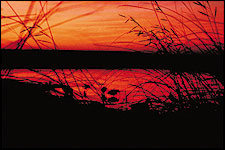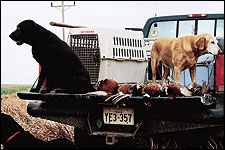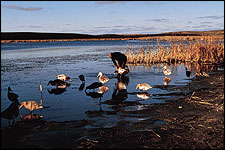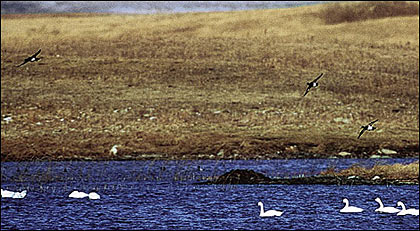The Lab is a great choice for prairie birds on land and water.
 An unforgettable North Dakota sunrise. |
With ducks and pheasants in the Dakota pothole country at their highest numbers in years, anyone who has the urge and the energy should make a trip there to experience hunting on the prairies. If you are willing to do a little research, some driving and can roll with the serendipitous punches of this surprisingly varied land, you can guide yourself to some wonderful hunts. If you want a little insurance, book some time with a guide. Either way you can be sure of shooting opportunities and a rewarding adventure.
And, as was to be my experience, if you have a young dog, there are few places in North America to rival the opportunities found in the Dakotas.
My first hunt on the prairie was in October, 1996 when I joined some friends to hunt pheasants and ducks with Mike Moody, owner of South Dakota Hunting Service. Mike runs combination duck and pheasant hunts on the southern end of the Missouri Cocteau just north of Pierre, South Dakota. Having spent most of my duck hunting life with black ducks in the salt marshes of New England, I could not get over the number of ducks I saw. Every pothole we drove by seemed to be covered and the pre-dawn flights to the grain fields were awe-inspiring. On my first morning's hunt I shot a limit of five ducks, all different species. I was hooked.
On the flight home I decided that I would return for a guided hunt the following year, but before I did that I would drive out and guide myself for a week. This way, I could bring a new dog--a Lab I had been dreaming about.
Using a variety of resources, I decided to hunt the "Cocteaus des Prairies" region in northeastern South Dakota. There was ample water there, sufficient public land and it was the shortest drive. I couldn't get any of my hunting friends to take two weeks off, so I asked my future wife if she would join me. The local Chamber of Commerce had steered us to a bed and breakfast on a dairy farm outside of Webster.
We were fortunate to be able to hunt the farm property as well as WMAs and WPAs in the area. We arrived about a week after the opening, the weather was cold and snowy, there were plenty of mallards and gadwall around and we had great shooting.
After a week, I dropped Marsha off in Sioux Falls, picked up a hunting buddy and headed out to Mike Moody's. The prior winter had been the worst in 100 years in the Dakotas, causing a large winter kill of pheasants. Roosters were hard to find compared to the prior year, but the duck hunting was fast and furious every day. There was water everywhere, and where there was water, there were ducks.
 One of many successful hunts for Dakota pheasants. |
We did the same hunt in '98, again bringing our dogs. Unlike '97 the weather was unseasonably warm, and the migration was in limbo. The ducks had been hanging in the same area for a while and in most cases--but not all--were smarter than we were. The pheasants in South Dakota had recovered remarkably in one year and we also had great teal shooting, which gave our nine-month-old female Lab, Hershey, a wonderful introduction to the field. For my young retriever, the place was a dream come true. While she had been exposed to basic training and introduction to guns and birds back home, the opportunity for many retrieves of various degrees of difficulty really lit the fire in her. I couldn't have been happier for both of us as the time flew by.
In 1999 I did not get a waterfowl license in the South Dakota lottery. Since North Dakota has a somewhat more open waterfowl-licensing system and plenty of prairie potholes, we decided to go there. We settled on the town of Napoleon, about 45 miles southeast of Bismarck. We thought the location would yield good duck hunting on the edge of the Missouri Cocteau and we would find pheasants along the southern border about an hour away.
Although unseasonably warm weather again held the big flights of puddle ducks north of the Canadian border, we still had good shooting most mornings and one truly spectacular evening of mallard shooting. Late harvesting of sunflower and corn fields meant that the pheasants were only too happy to hide there, but when we did find covers such as CRP or state-leased walk-in land next to recently cut fields, the pheasants were explosive.
While scouting in '99 we met rancher, Ray Heuple, at Ozzie's Cafe in the town of Medina which is about halfway between Jamestown and Bismarck. During a long conversation about cattle feeding and farming on the prairies we found that Ray has a Ducks Unlimited project on his family farm. In early spring 2000 we decided to drive out to Ray's to photograph the northward migration. Medina is on one edge of the Chase Lake Prairie Project--a 5.5-million acre tract of restored prairie grasses, potholes and farmlands that, besides being extremely attractive to ducks and geese, is home to the largest breeding population of white pelicans in North America. We found ducks everywhere. One small pothole at Ray's farm held several broods of mallards, redheads, shovelers and blue-winged teal at various stages of maturity. After a couple of days of driving to Medina from Jamestown, Ray sent us to stay at the Chase Lake Inn, a bed and breakfast just north of his place. The Inn sits on a rise between three potholes that were full of ducks, and coot. The location, and discovering that hunters could use the kitchen in the evenings, was all we needed to quickly make reservations for our fall hunt.
In mid-October we loaded layout boats, dog, floaters, silhouettes, guns, and clothes and headed West to the prairies again. We had decided to return this year to South Dakota for ducks and pheasants. Mike Moody had called a few weeks earlier to report that the Pheasants were thick on the ground, but the summer had been dry and duck hunting might be spotty. Even with this cautionary note I was sure we couldn't possibly fit enough coolers in the car to ship back all the birds we were going to shoot.
 Setting out silhouettes in North Dakota. |
Because of the warm weather the previous year we moved our trip dates back arriving in Medina on October 22. We had scheduled a week at Chase Lake with a break for South Dakota, then a return the first week of November in hopes of hitting the peak of the migration. The day we arrive
d certainly was promising. The wind was blowing 35 miles an hour out of the southeast, there were ducks and geese piled outside the cleaning shed at the Inn, and broad smiles on all the hunters' faces. However, the weather quieted down the following day and remained warm. It was so warm that we traded our 5mm neoprene waders for our lightweight fishing waders. A dozen floaters were too hot to carry the three quarters of a mile we walked in to some of the potholes, so we reduced to our packs to five decoys and a few silhouettes. In the middle of the week we had tremendous thunderstorms and rain with wind that moved the birds for a day, but after that it cleared and warmed up again.
We would get a few shots at first light, but for the rest of the day it was quiet with the birds resting and feeding until they began to move again in the late afternoon. We took advantage of the mid-day lull to scout potholes and to hunt for pheasant and sharptails in CRP and state-leased walk-in land (called P.L.O.T.S.). The pheasant hunting was fair and the dogs loved the upland work.
We had decided to concentrate on puddle ducks. There were plenty of small potholes to choose from with at least some ducks on them. Although we had brought along a portable blind we found hiding in the grass or cattails around the edges of the potholes worked well enough.
Although there were a good number of puddle ducks around, the major flight consisted of divers. Every day there were more bluebills and redheads on both large and small potholes. We never set up specifically for divers, which was a mistake. There was a lot of action to be had and, in that part of the flyway bluebills are very good eating. On our first rainy, windy day we did put a couple of strings of diver dekes out next to the mallards and had great action (but not great shooting--I had some trouble adjusting to those fast, low-flying divers). As the week went on, with the weather remaining quiet, puddle duck shooting slowed down with even the morning shoot getting sparse. Others who were hunting from the Inn had the same experience until the weather changed. There was more rain and wind on Saturday, and large flights of presumably "new" birds moved in.
 Bluebills coming in low near Chase Lake. |
This was Hershey's third year of duck hunting on the plains. I expected her to be steady to wing and shot and, since we had been working all summer on hand signals, I had also expected her to obey them if need be. So much for expectations.
Hershey broke on the first duck I shot and got about three steps into the water before I vocally caught her and brought her back. She was a little better on the next bird, but I was wondering if I was going to have to put her on a lead again. The first afternoon she broke again on a mallard drake that I shot after it surprised us both by landing right in the decoys. However, a little later I had a perfect training opportunity when a gadwall landed upwind of our island hiding place, sat for a while then got up and flew right over us. I was able to give Hershey a whispered command to "stay." I shot the bird as it flew over and waited a bit before sending her. From then on she held nicely when any birds came into the decoys. Again, nothing is better for dogs than real experience and the opportunities came quickly and often.
There were a couple of dozen hunters at the Inn. This never caused any problems during the day because each had his own special place to hunt and there were plenty of spots within almost any distance you would choose to travel. In the evenings we were able to share our day's adventures as each party's designated chef cooked up the ducks of the day. We all enjoyed swapping recipes and getting to sample each other's cooking. Among the treats were sauteed blue-wing breasts with onions, marinated and charcoal-broiled bluebill, and roasted redhead with red currant jelly sauce. Each evening was a new eating adventure. During our first week Minnesota and Wisconsin had their annual teacher's conventions. That school holiday brought several large families to the Inn. It was a real treat to see the smiles on the kid's faces when they returned in the evening from a successful day's hunt.
After a week at Chase Lake we moved about five hours south to Onida, South Dakota. The migration was late, of course, but we still had three good morning waterfowl hunts. The most memorable was a foggy morning of field shooting for specklebelly geese. We could hear the birds coming long before we could see them. The geese were jumpy, and would flare off the decoys just out of shooting range, so we moved about 100 yards downwind of the spread and hunkered ourselves and Hershey under grass mats. The geese came out of the fog at what seemed to be head height although we had to be careful to wait for them to get directly over us or they would be out of range before we could get organized to shoot. I dropped two mature birds out of successive flights. That was a real relief because my shooting had been suffering from the "yips" after my afternoon's experience with the bluebills. Hershey hit the big birds as if she had been doing it for years.
The pheasants were thick. For the first couple of afternoons of mild temperatures and calm winds the roosters held tight. Of course, in many fields they were hiding in five-foot-high, almost impenetrable cattails--holding tight was the smart thing to do.
| PLANNING A DAKOTA HUNT | 

Wingshooter's Guide to South Dakota by Ben O. Williams and Chuck Johnson. 1996. Wilderness Adventures Press, Gallatin, MT., 800-925-3339. www.wildadv.com Wingshooter's Guide to North Dakota by Chuck Johnson with bird descriptions by Jason Smith. 1997. Wilderness Adventures Press South Dakota Department of GameFish & Parks, 312 West Missouri, Pierre, SD 57501-4521 605-773 -3485 North Dakota Game & Fish Department, 100 North Bismarck Expressway Bismarck, ND 58501 701-328-6300 North Dakota Atlas South Dakota Atlas Delorme Publishing, Box 298, Yarmouth, ME 04096 207-8467000 North Dakota State Highway Department Map Sales, 608 East Boulevard, Bismarck, ND 58505 701 328-2500 South Dakota Sportsman's Atlas Game, Fish & Parks, 523 East Capital, Pierre, SD 57501 South Dakota Hunting Service, Mike Moody, PO Box 324 Herrick, SD 57538 605-654-2465 Chase Lake Country Inn, Deb and Craig Hoffman, 2950 56th Avenue SE, Medina, ND 58467-6601 701 486-3502
|
|
We hunted with the guides our first afternoon, since we were the only "sports" in camp and in those big fields you need numbers in order to keep the roosters from just running around us. The first section of CRP was about a mile out of town covered in shin high grass and weeds and loaded with roosters. We ran five Labs through the field, the birds held tight for them and we came out of the field with eight of our nine-bird, three-man limit.
Working the cattails along the edge of a wheat field later that afternoon we got a lesson in why your dog needs to get right on a downed rooster. Hershey had worked a scent trail along the field edge with me in hot--and weary--pursuit. She swung into some thick cover and the rooster exploded across the field. Shooting my Beretta 12 I put the first round right on him--feathers all over the place! The rooster hit hard in the open field, but was up and away at a gallop. He ran more than a hundred yards along a little ridge in the wheat field with Hershey just a bite short of his tail. I think they would be running still if the rooster hadn't made the mistake of heading back to the cattails. Hershey had the advantage in the thick stuff and ended the chase.
After three very full days in South Dakota we arrived back in Medina on November 1 to cold temperatures and snow. The prospects looked great for ducks. We drove out for a quick scout before dark and spotted one pothole covered with birds. We decided to walk in there the next morning. The weather cleared over night and our pothole had skim ice around the edges and well out toward the center. We kicked out 30 or so birds, both mallards and gadwall. As we set out the decoys, the birds kept coming back to the pothole, some landing, others just swinging it. When shooting time arrived, it didn't take long to limit. What a sight it was with singles, pairs and flocks of mostly gadwalls swinging into the dekes out of that beautiful Dakota sunrise.
We shot the same pothole the next morning with the same result. It was really rewarding to watch Hershey retrieve the downed birds. Even though she was so stiff from her all-day hunts in South Dakota that we had to help her out of her crate in the morning, she would soon limber up and mark the falls beautifully. I couldn't help being proud of some of her difficult retrieves on crippled birds in the cattails on the opposite side of the pothole. It was a real pleasure to watch her line and work scent once she was in the area of the fall. It was clear that after two weeks she was confident and we could be as certain as possible that we would pick up any bird that we shot.
The weather forecast called for snow the following day, but leg weary from our pheasant hunting and, knowing that the gunning could not improve much over our experience the last two mornings, we decided to pull out and head home. Will we be back again next year?
We've already made our plans.
To Continue Reading
Go Premium Today.
Get everything Gun Dog has to offer. What's Included
- Receive (6) 120-page magazines filled with the best dog training advice from expert trainers
- Exclusive bird dog training videos presented by Gun Dog experts.
- Complete access to a library of digital back issues spanning years of Gun Dog magazine.
- Unique editorial written exclusively for premium members.
- Ad-free experience at GunDogMag.com.
Subscribe Now
Already a subscriber? Sign In or start your online account
More You May Be Interested In

Get Digital Access.
All Gun Dog subscribers now have digital access to their magazine content. This means you have the option to read your magazine on most popular phones and tablets.
To get started, click the link below to visit mymagnow.com and learn how to access your digital magazine.
Get Digital Access

Gun Dog Premium is the go-to choice for sporting dog owners and upland hunting enthusiasts. Go Premium to recieve the follwing benefits:
Recieve (6) 120-page magazines filled with the best dog training advice from expert trainers.
Exclusive bird dog training videos presented by Gun Dog experts.
Complete access to a library of digital back issues spanning years of Gun Dog magazine.
Exclusive Online Editorial
Unique editorial written exclusively for premium members.
Subscribe Now
Already a subscriber? Sign In or Start your online account
SUBSCRIBE TODAY
Go Premium
and get everything Gun Dog has to offer.
Recieve (6) 120-page magazines filled with the best dog training advice from expert trainers.
Exclusive bird dog training videos presented by Gun Dog experts.
Complete access to a library of digital back issues spanning years of Gun Dog magazine.
Exclusive Online Editorial
Unique editorial written exclusively for premium members.
Subscribe Now
Already a subscriber? Sign In or Start your online account